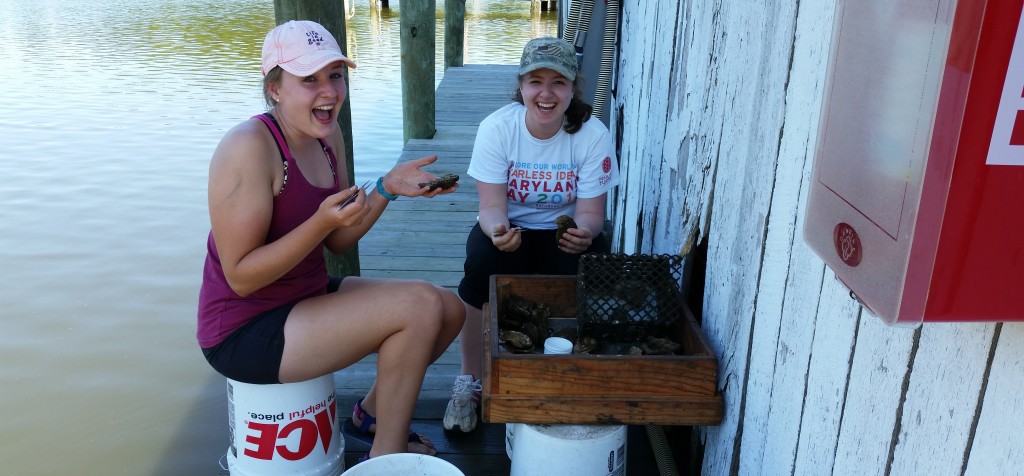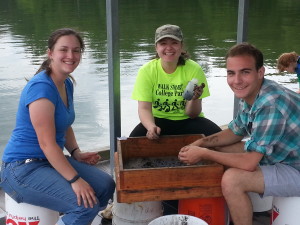by Maria Sharova
SERC citizen science program assistant

Maria Sharova (right) sifts through oyster shells in search of tiny mud crabs with intern Caroline Kanaskie. (Monaca Noble/SERC)
I started working at the Smithsonian Environmental Research Center (SERC) one year ago this month. It had only been two weeks since I graduated from college with a bachelor’s degree in anthropology. Like any recent grad, I was excited and nervous to start my first real job—and, frankly, I wasn’t entirely sure what to expect.
During my first week of work, I was involved with the Chesapeake Bay Parasite Project (a.k.a. the Mud Crab Project), a project that looks at the impact of an invasive, parasitic barnacle called Loxothylacus panopaei (“Loxo” for short) on native white-fingered mud crabs in the Chesapeake Bay. Like most of our volunteers, I’d never heard of either of these organisms, I had no idea why the project mattered, and I’d never been involved in any kind of ecology research before. I had no idea Loxo was able hijack a mud crab’s reproductive system, forcing them to nurse parasite larvae instead of crab larvae. Nor had I ever searched through crates of oyster shells looking for mud crabs the size of a quarter or smaller, as our volunteers were about to do. But in no time at all, I’d become an experienced mud crab finder!
Maria’s Pro Tips for Citizen Scientists
Just in case you’re worried that you don’t have enough experience or don’t know enough about mud crabs, I thought that I’d share a few of the things that I learned along the way:
- Most tasks aren’t hard. It’s mostly counting, measuring, and recording.
- Mud crabs can be tiny—really, really tiny. Picking mud crabs from the oyster shell sounds super easy, but it takes patience and practice.
- Like with most of SERC’s citizen science projects, volunteers work alongside researchers. Don’t be afraid to ask them questions—they love talking about their work!
- Bring sunscreen and a hat. You don’t want to be the person who gets lobster-red.
- Participating in this project is a great way to interact with people who live here! One of my favorite parts of participating last summer was learning how different volunteers heard about the project, why they were interested, and what they do when they aren’t searching for mud crabs. Although we are doing real research, this was a great chance to get to know the communities around SERC.

Maria Sharova (center) beside a crate for searching for mud crabs SERC docks, with interns Sarah Janesko and Jacob Saindon. (Alison Cawood/SERC)
How to Get Involved
So whether you are an experienced ecologist or a first-time citizen scientist, you can contribute valuable data to really interesting research. Come join us this summer to see how—and don’t forget your sunscreen! Volunteers are needed on June 11 & 12, and June 18 & 19. Sign up to join the Chesapeake Bay Parasite Project here.
Full details on the Chesapeake Bay Parasite Project >>
We also need volunteers to look for lost artifacts during our Archaeology Dig Days on June 18 & 27. Learn more about Dig Days.

